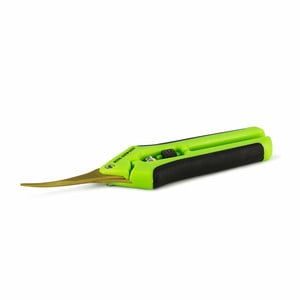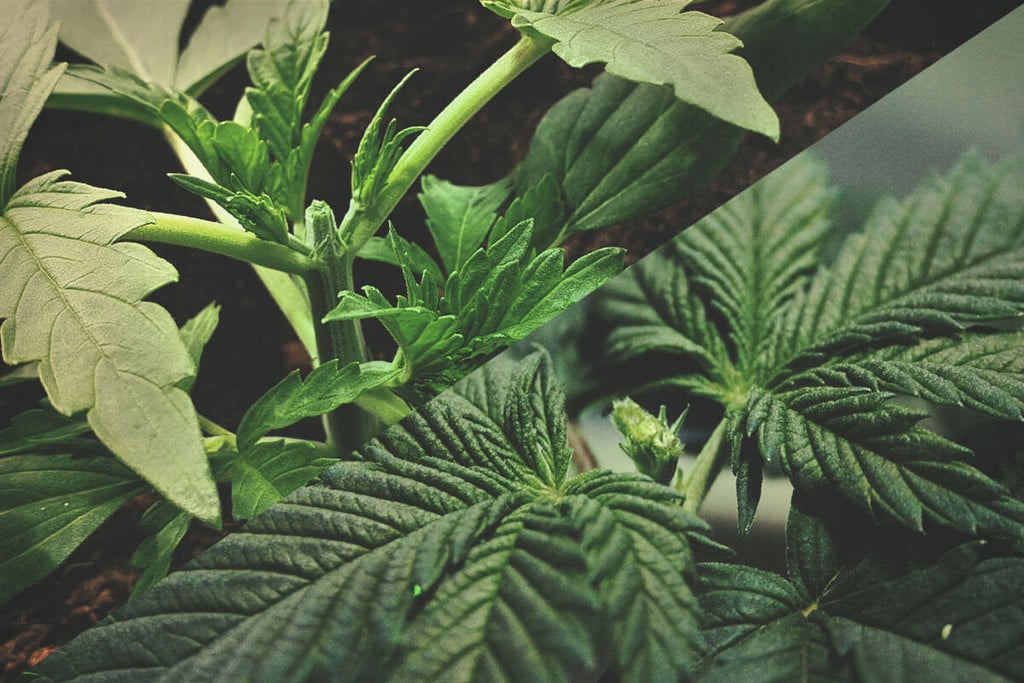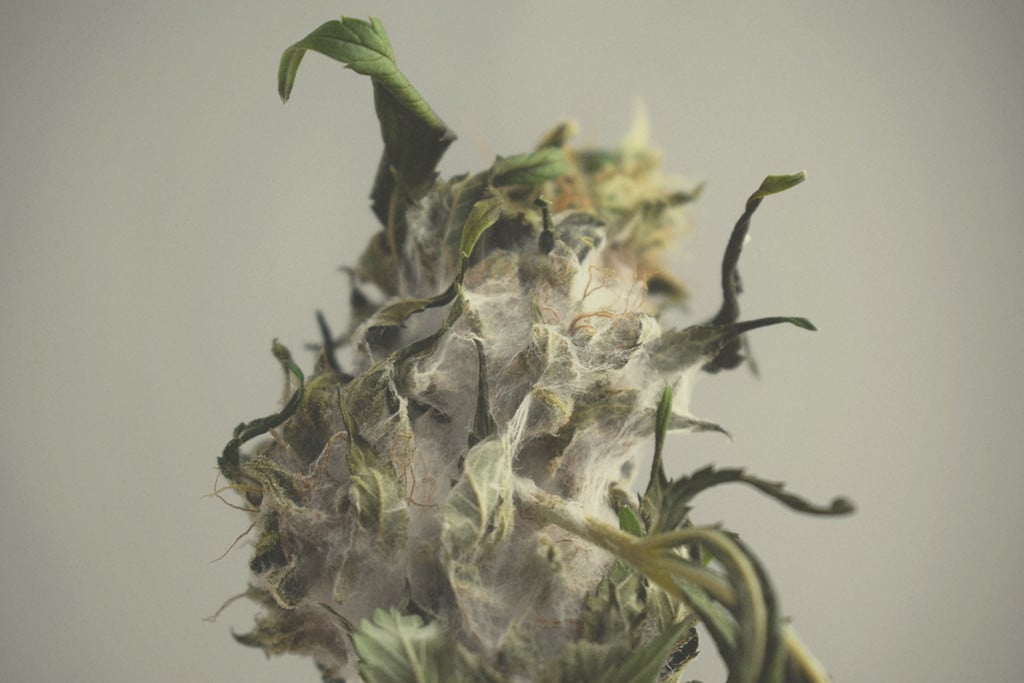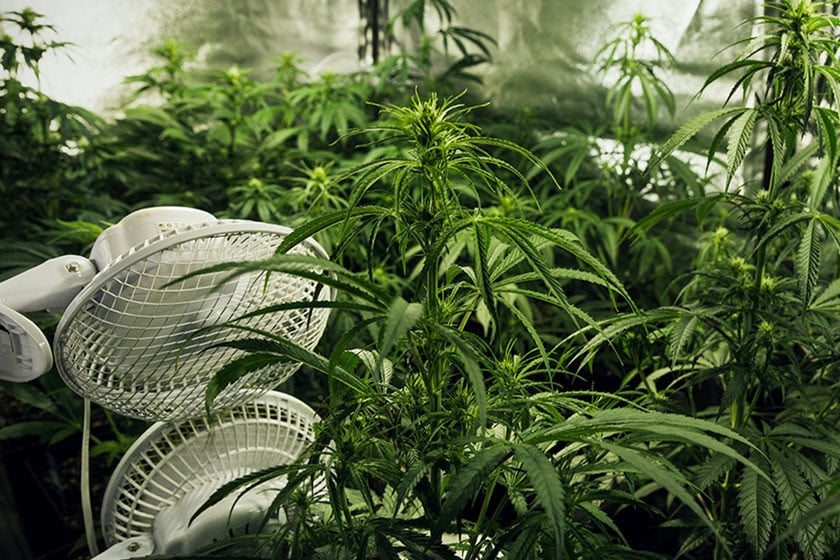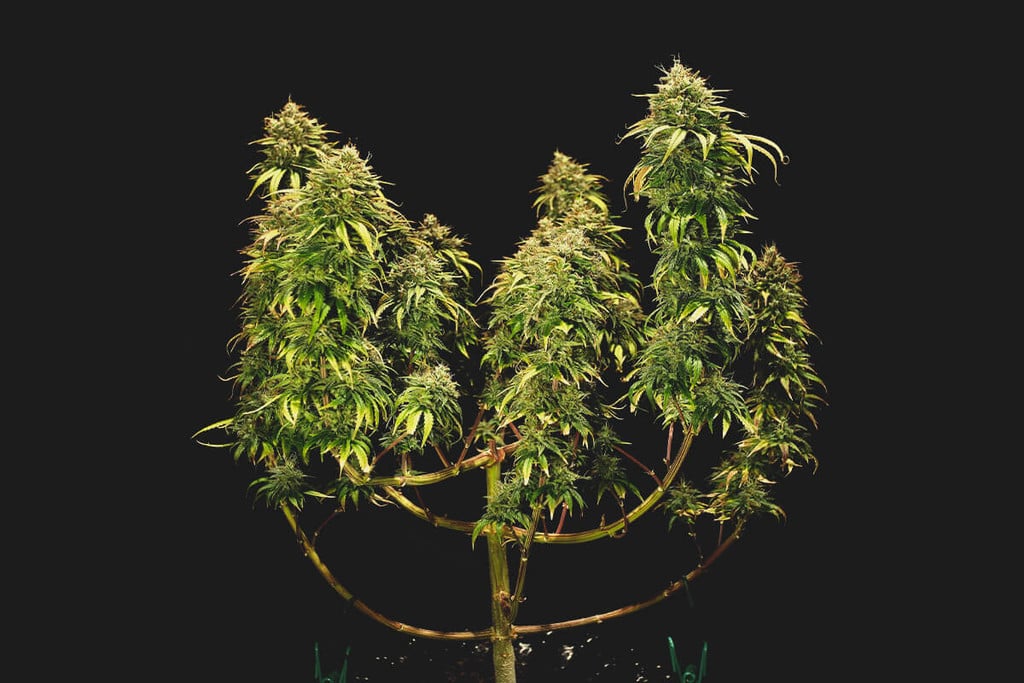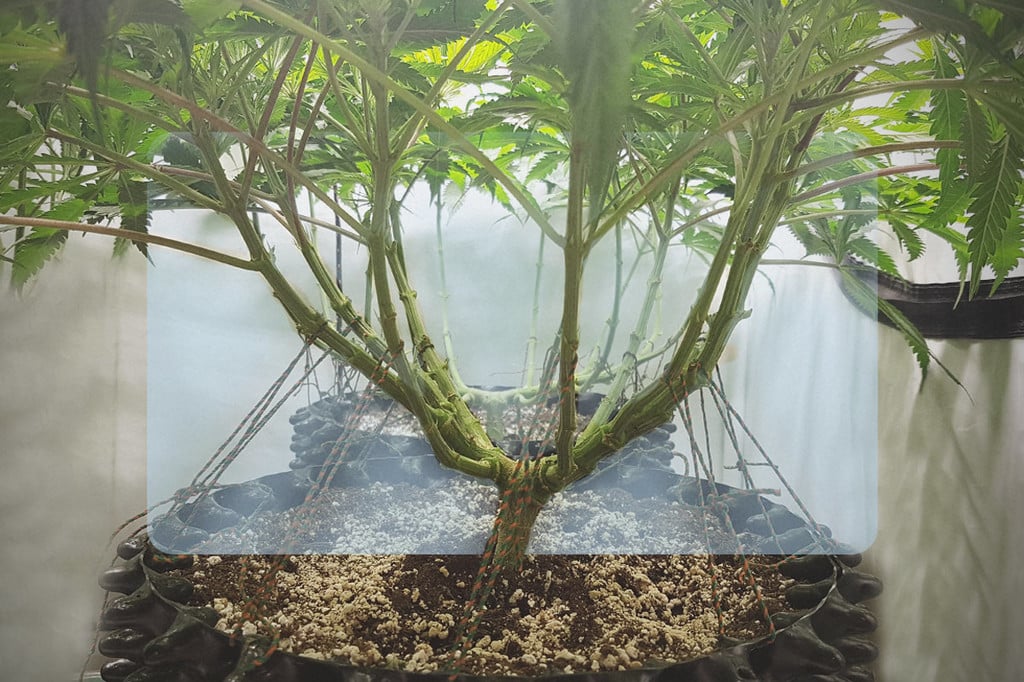 Weed Grow Guide by Royal Queen Seeds
Weed Grow Guide by Royal Queen Seeds
- Growing weed step by step
- Cannabis growing basics
- Choosing your seeds
- How to germinate seeds
- The cannabis vegetative stage
- The cannabis flowering stage
- Harvesting cannabis
- Trimming, drying, and curing
- Choosing pots and soil
-
Growing indoors
- A Complete Overview Of Growing Cannabis Indoors
- Cannabis Cultivation Tips: How To Set Up Indoor Grow Lights
- How Many Cannabis Plants Can You Grow Per Square Metre?
- Indoor Cannabis Growing: Relative Humidity and Temperatures
- Hydroponics Cannabis Growing Guide (with diagrams)
- Cannabis Micro Growing: Growing Great Weed in Tiny Spaces
- Growing outdoors
- How to grow autoflowering cannabis
- Cannabis nutrients and pH
- Cannabis troubleshooting: Nutrients
-
Cannabis troubleshooting: Growing
- Cannabis Seed Germination — Troubleshooting Guide
- How to Deal With Pythium (Root Rot) in Cannabis Plants
- Slow Cannabis Plant Growth And What You Can Do About It
- How to Deal With Leggy Cannabis Seedlings
- Watering Your Cannabis: How to Fix Overwatering and Underwatering
- Understanding Male, Female, And Hermaphrodite Cannabis
- Identifying and Treating Common Cannabis Ailments
- How To Revive a Sick Cannabis Plant
- How to Avoid Mouldy Weed During Drying and Curing
- How to Prevent and Treat Dry and Crispy Cannabis Leaves
- What Cannabis Leaves Can Tell You
- Causes and Solutions for Yellow Cannabis Leaves
-
Cannabis Strains Grow Report
- HulkBerry Automatic Grow Report
- Blue Cheese Auto Grow Report
- Purple Punch Automatic Strain Grow Report
- Triple G Automatic Grow Report
- Do-Si-Dos Automatic Grow Report
- Green Gelato Automatic Grow Report
- Haze Berry Automatic Grow Report
- Purple Queen Automatic Grow Report
- Cookies Gelato Automatic Grow Report
- Sherbet Queen Automatic Grow Report
- Sweet Skunk Automatic Grow Report
- Medusa F1 Grow Report
- Cannabis plant training
-
Weed growing tips
- The Cannabis Plant Anatomy
- How to preserve seeds - UK
- How Much Sunlight Do Outdoor Cannabis Plants Need To Grow?
- How to Control and Prevent Stretching in Cannabis Plants
- My Cannabis Plants Are Growing Too Tall: What Should I Do?
- Should You Worry About Purple Or Red Cannabis Stems?
- What To Do When Your Indoor Cannabis Won’t Flower
- How To Protect Your Cannabis Plants From Heat Stress
- How To Tell If Your Female Cannabis Plant Has Been Pollinated
- Growing Medical Marijuana
- Bud Washing: How to Clean Your Weed
- Understanding Cannabis Yield per Plant
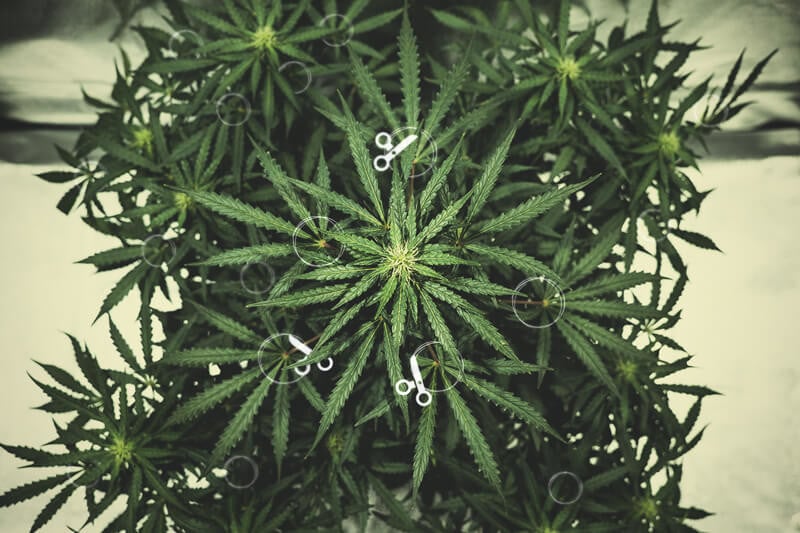
Defoliation – A High Risk Way To Increase Yield
Contents:
There are many ways you can intervene with a cannabis plant’s growth to improve yield quality and size. One of these methods, defoliation, involves stripping a plant of its excess foliage to improve light penetration and airflow.
While it’s a controversial method, we’re firm believers in its ability to improve the quality and size of cannabis yields.
What is cannabis defoliation?
While it's simple enough, there’s definitely some risk involved with defoliation. Specifically, it’s all too easy to over-defoliate a plant, stunt its growth, and remove nodes that could’ve developed some great bud.
Many growers question defoliation. After all, why would a plant waste energy on growing unnecessary foliage? Well, in nature, cannabis plants use their leaves to store nutrients for stressful times like droughts, nutrient shortages, and pest infestations.
When you’re growing indoors, however, a lot of this excess foliage becomes unnecessary. After all, unlike out in the wild, indoor plants grow in carefully controlled environments with, ideally, perfect temperature and humidity levels and a low risk of pests. In this environment, the thick foliage becomes more of a burden.
That's where defoliation comes in; by removing some of this excess foliage, not only do you free up some of your plant's energy (by reducing the amount of foliage it needs to keep alive), but you help your plant make better use of its limited light source. Finally, defoliation also improves airflow around your plants, which in turn helps reduce temperature/humidity issues and the risk of pests/mould.
Note: Some growers confuse defoliation with lollipopping. While lollipopping does necessitate removing foliage, it involves stripping the entire bottom part of a plant, including the nodes (and sometimes removing entire branches), leaving the branches mostly bare like a lollipop stick. Defoliation, on the other hand, involves strategically removing leaves from different areas of the plant, and doesn't inherently involve removing bud sites or branches.
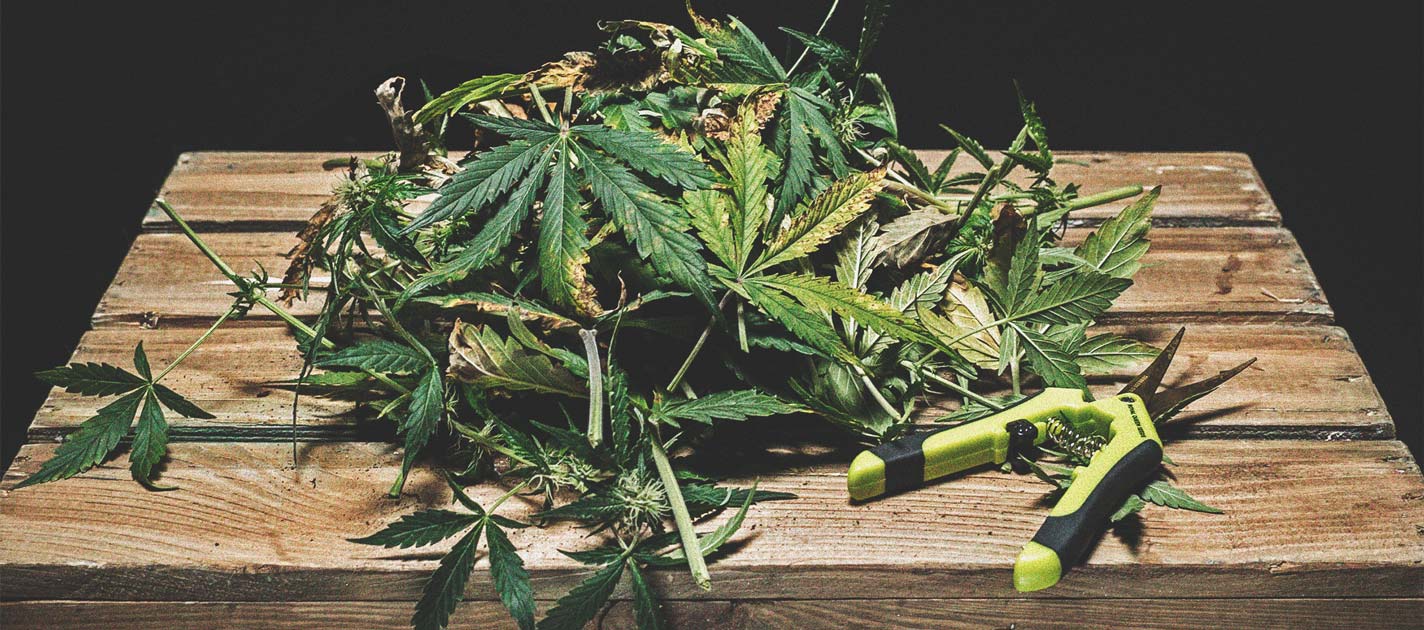
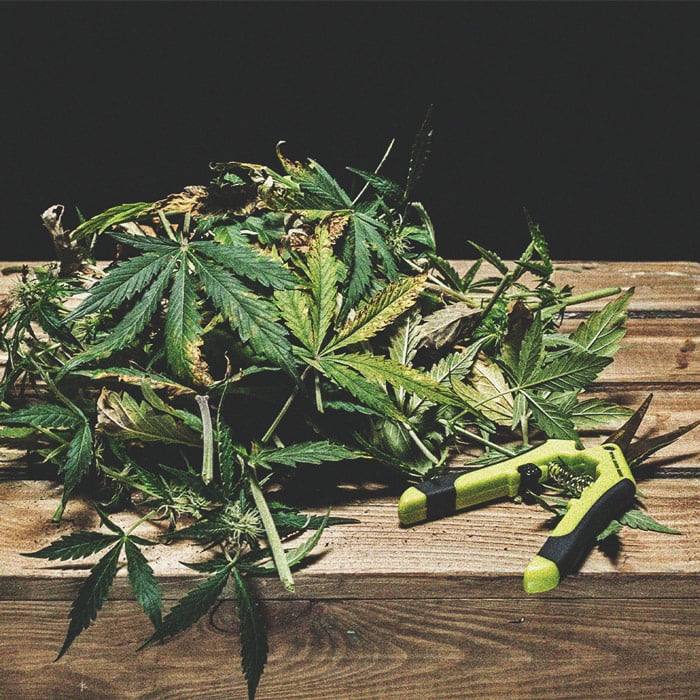
The benefits of defoliating cannabis plants
To better understand the benefits of defoliation, it helps to first understand that cannabis plants have a finite amount of energy at their disposal to fuel growth. This is governed by several factors, mainly the amount of available soil, the nutrient content of that soil, humidity and temperature levels, and the amount of light.
In an indoor grow room, you’re at liberty to give your plants the right nutrients just when they need them, and can control both temperature and humidity to a tee. However, the amount of light, soil, and space your plants have at their disposal indoors is far less than what they'd get in nature.
By carefully removing foliage that won't support the development of buds, you'll be helping your plant make better use of the finite amount of energy it can produce with its limited resources.
Removing this foliage will also make it easier for air to circulate around your plants and the room. This in itself has a lot of benefits; not only will it help keep temperature and humidity consistent throughout your grow space, but it will reduce the risk of mould and pest infestations (which naturally flourish in warm, humid conditions).
| Benefits of Defoliation |
| Helps your plant making use of the amount of energy she can produce |
| Increases air circulation |
| Reduces the risk of mould and pest infestations |
| Benefits of Defoliation |
| Helps your plant making use of the amount of energy she can produce |
| Increases air circulation |
| Reduces the risk of mould and pest infestations |
Picking the right cannabis plants for defoliation
Removing healthy foliage stresses your plants. Hence, you should only defoliate plants that are 100% healthy; strong, upright stems, green leaves, fast growth, and a well-draining, fast-drying medium are all telltale signs that your plants are happy.
Don't defoliate any plants that look visibly frail or show symptoms of a nutrient deficiency, over or under-watering, nutrient or light burn, wind damage, or pests/disease. Defoliating these plants will only cause more stress than they can feasibly recover from.
We also only recommend defoliating indoor plants. As we mentioned earlier, cannabis plants actually store energy in their leaves for when they're exposed to stress. Because outdoor plants are exposed to more consistent environmental stress (like droughts, storms, harsh winds, or temperature/humidity fluctuations) as well as pests, we don't recommend defoliating them.
Plus, unlike indoor grow lights, the sun changes its position throughout the day and is capable of penetrating even extremely bushy plants, meaning outdoor plants get much more (and far better) light exposure. Thus, they don't benefit from defoliation in the same way as indoor plants.
| Candidates for defoliation |
| Strong, upright stems |
| Green leaves |
| Fast growth |
| A well-draining, fast-drying medium |
| Candidates for defoliation |
| Strong, upright stems |
| Green leaves |
| Reduces the risk of mould and pest infestations |
| A well-draining, fast-drying medium |
How to defoliate cannabis plants
The key to properly defoliating cannabis plants is, of course, knowing what foliage to remove. At the same time, it’s also key to know when to defoliate. Ideally, we recommend defoliating your plants once during veg and once during flower.
If you're an inexperienced grower, only defoliate once during veg. If you are more experienced, you may want to try defoliating multiple times (given your grow schedule allows enough time for plants to recover after each defoliation).
Looking for safe growing tips? Get a broader look at plant care in our Grow Guide!
Free RQS
Grow Guide!
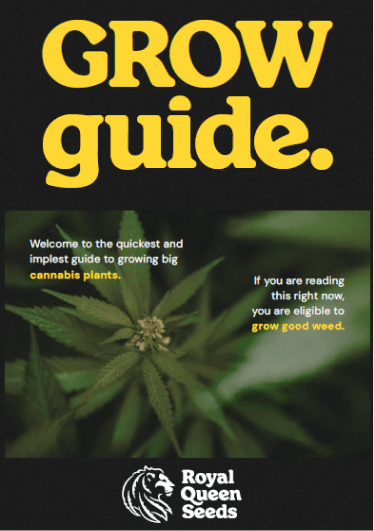
Vegetative phase
We recommend defoliating vegging plants just before you switch them to bloom:
- Start by removing big, hand-sized fan leaves first. These tend to overshadow almost anything below them, making it hard for light to properly penetrate your plant's canopy.
- Next, remove any leaves that grow towards the inside of your cannabis plant. These also tend to overshadow important bud sites.
- Finally, remove any old, yellowing foliage.
If this is your first time, we recommend defoliating only the bottom half of your plant. If there's any doubt about removing a particular leaf, play it safe and leave it in place. Don't remove more than 10–15% of a single plant's foliage.
If you're more experienced, however, we recommend defoliating from the bottom of your plant up to 3–4 nodes from the top of the canopy. Healthy plants should be able to handle having 20–25% of their foliage removed (given that you're not removing anything vital to your plant's development).
For even better results, combine defoliation with lollipopping and pruning to really help your plant make the most of its limited energy. Finally, once you've finished defoliating your vegging plants, give them 2–3 days of rest before switching their lights to 12/12.
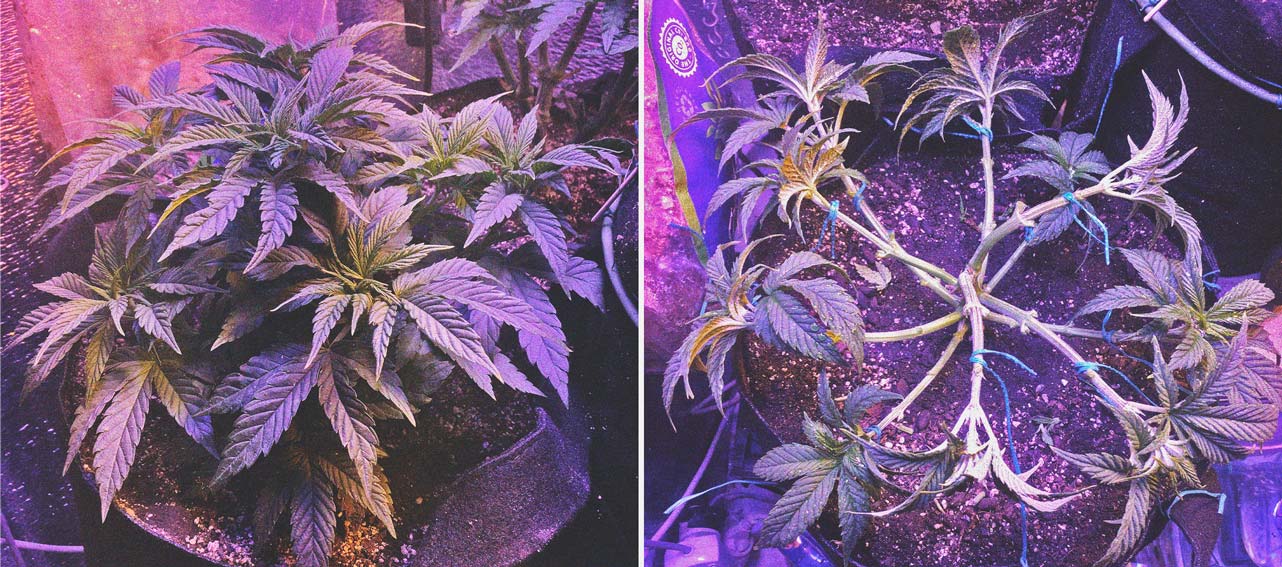
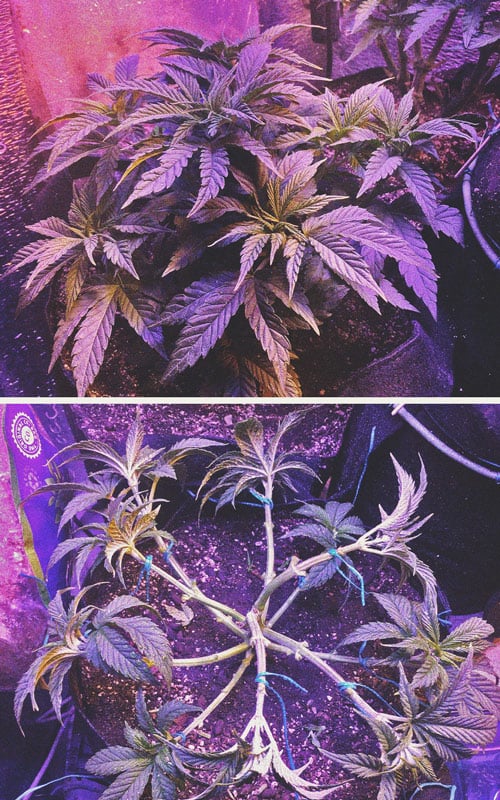
Flowering phase
For best results, we recommend defoliating your plants a second time, roughly 3 weeks into the flowering phase. Follow the same steps listed above, but be a bit more prudent about the foliage you remove. Again, if you're a beginner, play it safe and only remove big fan leaves. Also, remember to be extra careful when handling your plants to avoid disturbing any of their young buds.
After this light defoliation, simply feed and water according to your regular schedule, giving your plants time to develop their flowers.
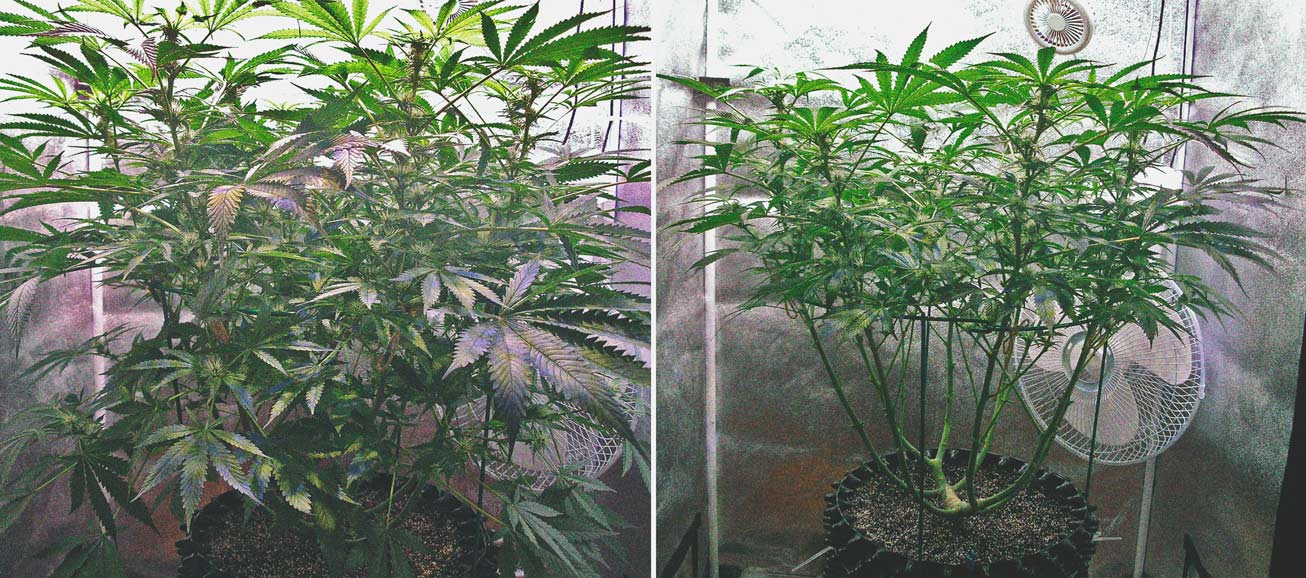
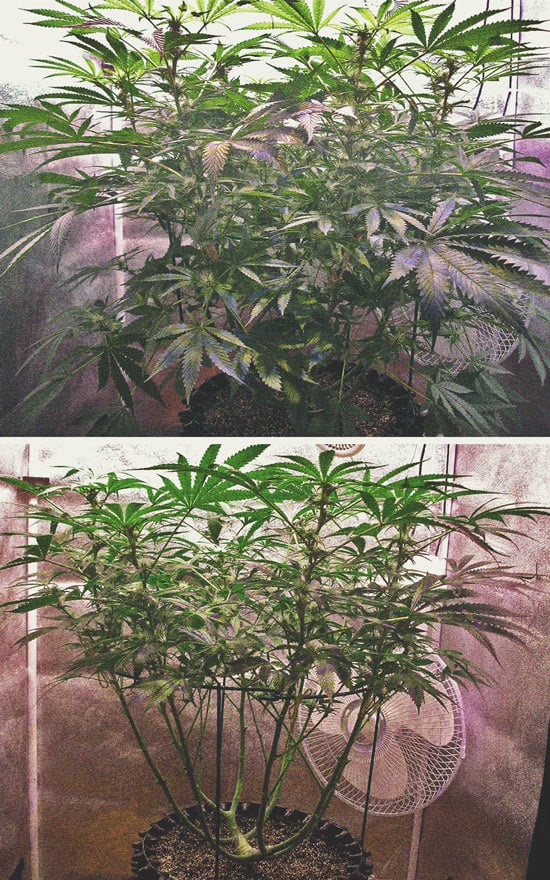
Knowing what foliage (and how much) to remove
Defoliation is an art form, if only in the sense that there are no definitive guidelines on how to do it. With time, however, you’ll automatically know what leaves to remove from your plants and how much cutting they can handle.
If you’ve never defoliated before, we recommend you always play it safe and stick to removing only the foliage that very obviously impedes bud production.
Focus on big fan leaves and interior foliage that’s already covering bud sites.
Quick tips to optimise defoliation
- The key to getting big harvests indoors is to grow low, flat, and wide. Your plants need a solid canopy to power their growth.
- Start low. Most of a plant’s bottom foliage is pretty safe to remove.
- Start slow. It can be easy to get lost in the rhythm of defoliating; then, before you know it, you’ve stripped your plant of half its leaves. Stay focused and move slowly to avoid removing too much. First-timers should aim to remove no more than 10–15% of total foliage at a time.
- Use sharp scissors. Our curved trimming scissors are great for making precise cuts when defoliating and trimming post-harvest. Remember to always keep your scissors clean to minimise the risk of disease and infection.
- Different strains can handle different amounts of defoliation. Bushy indicas, for example, tend to cope particularly well with defoliation, whereas sativas tend to naturally produce fewer leaves, and thus can't handle as much.
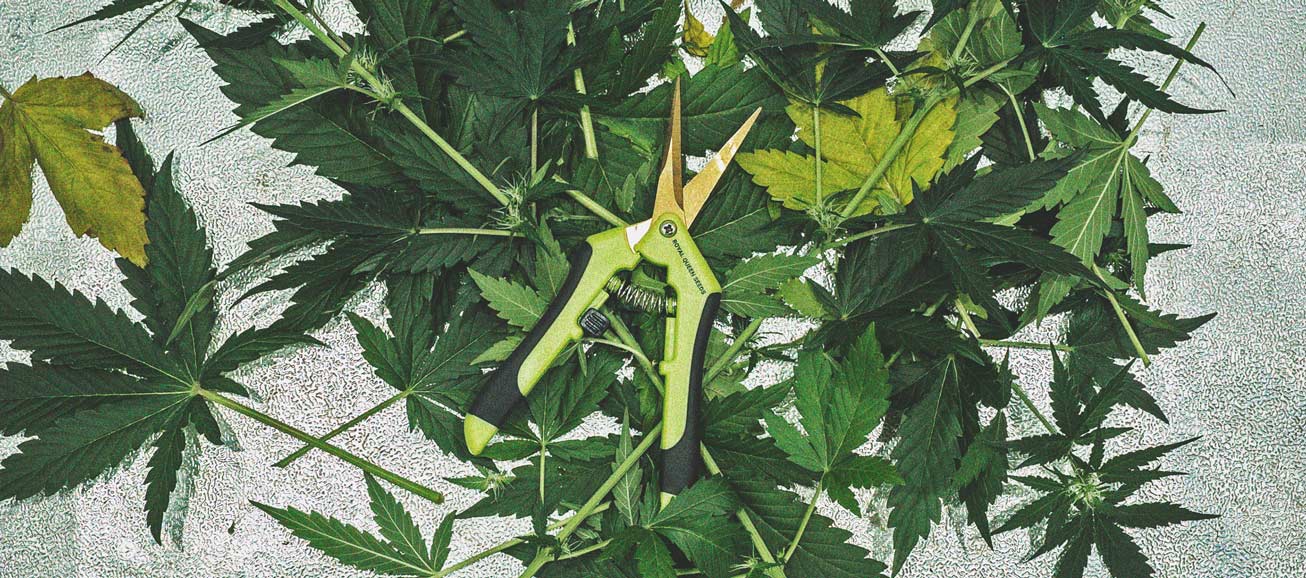
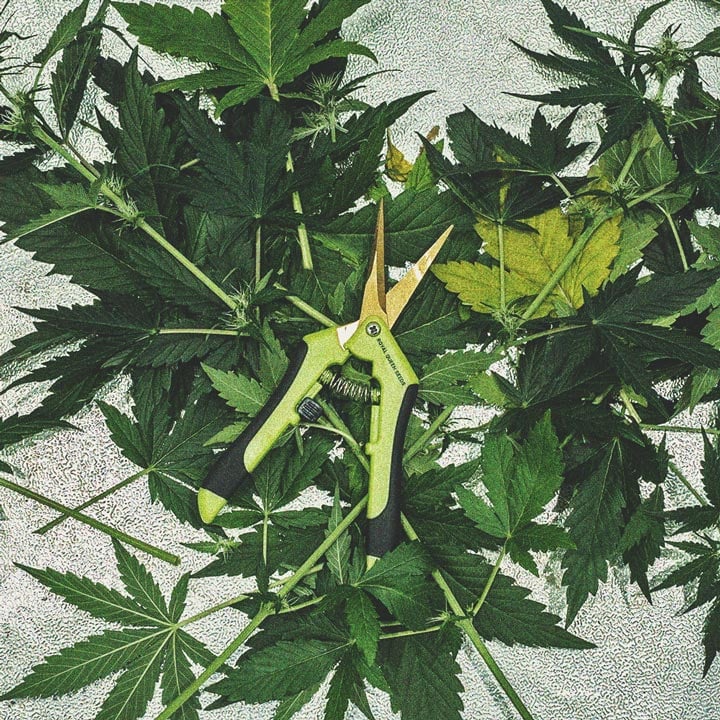
Defoliation vs pruning — understanding the differences
Pruning is a separate HST technique that many growers confuse with defoliation. The former is much more aggressive and involves removing entire branches and nodes in addition to leaves. While it might seem counterintuitive, pruning is actually very effective. It helps your plant focus its energy exclusively on the nodes that receive the best light. After that’s done, ideally, it’ll produce the biggest, densest, and most potent flowers possible.
Defoliation, on the other hand, only involves removing the leaves. That said, many cultivators use defoliation alongside pruning to optimise production, or they’ll use it alongside lollipopping, which we explained in more detail above.
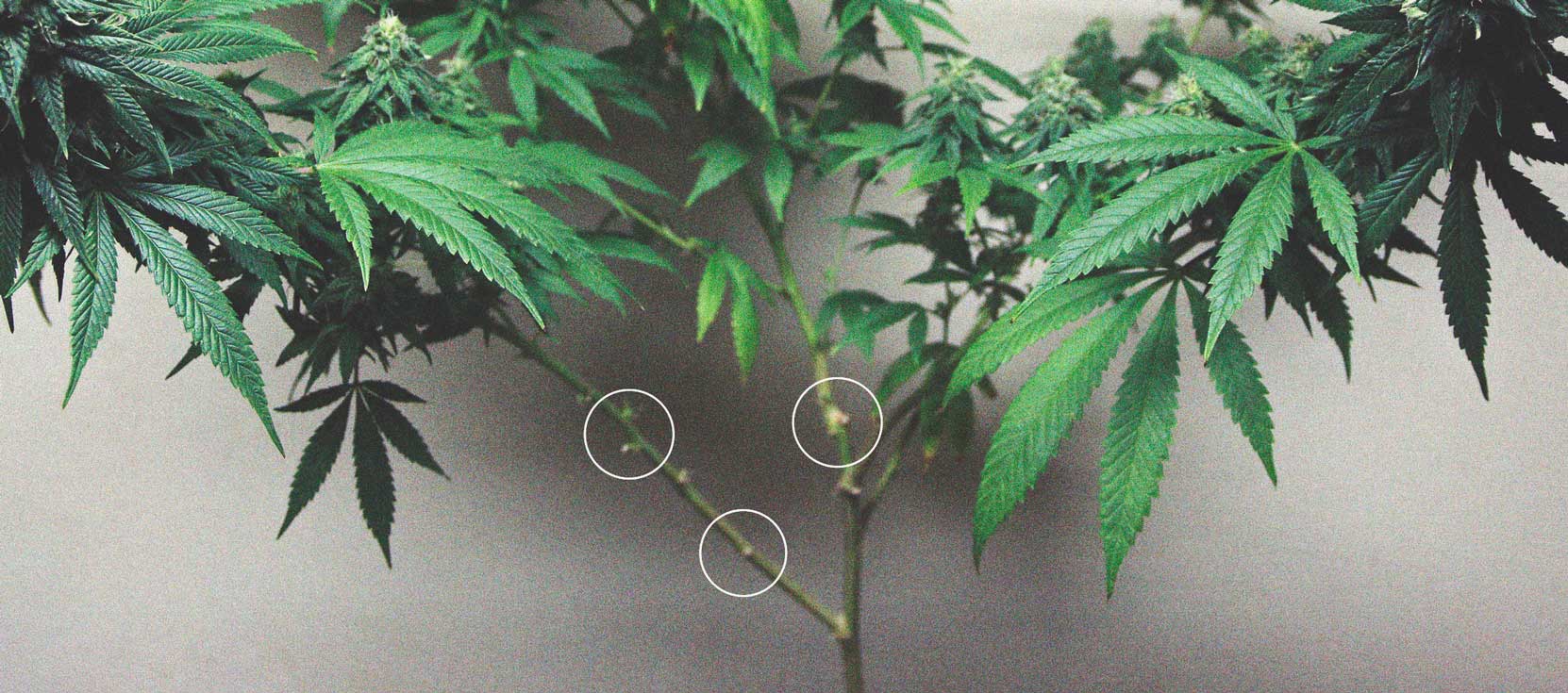
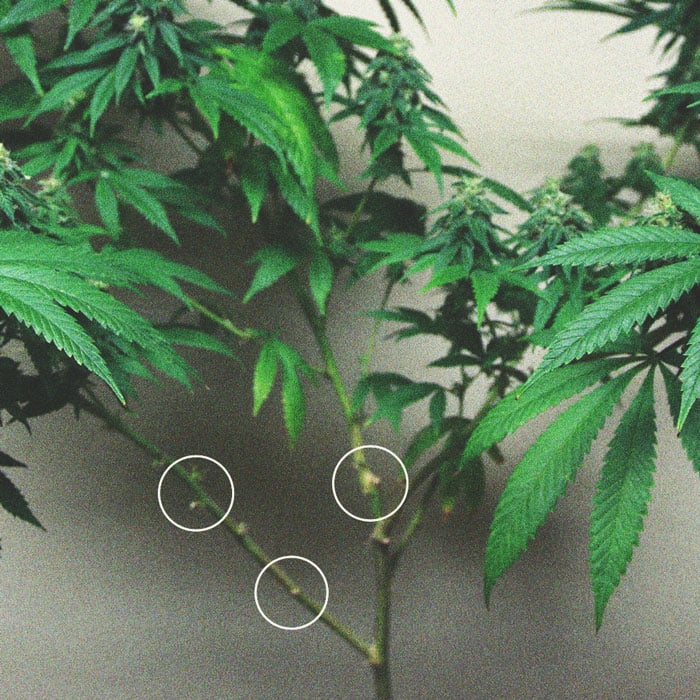
Give cannabis defoliation a try!
To really maximise your plants’ potential, you'll want to combine defoliation with other training techniques like LST, main-lining, lollipopping, topping, and super cropping. As you get more experienced, you’ll learn how to finesse these techniques to produce bigger, tastier, and more potent harvests. No matter what you do, we hope you enjoy the process!
 Grow Guide Topic Finder
Grow Guide Topic Finder
- Growing weed step by step
- Cannabis growing basics
- Choosing your seeds
- How to germinate seeds
- The cannabis vegetative stage
- The cannabis flowering stage
- Harvesting cannabis
- Trimming, drying, and curing
- Choosing pots and soil
-
Growing indoors
- A Complete Overview Of Growing Cannabis Indoors
- Cannabis Cultivation Tips: How To Set Up Indoor Grow Lights
- How Many Cannabis Plants Can You Grow Per Square Metre?
- Indoor Cannabis Growing: Relative Humidity and Temperatures
- Hydroponics Cannabis Growing Guide (with diagrams)
- Cannabis Micro Growing: Growing Great Weed in Tiny Spaces
- Growing outdoors
- How to grow autoflowering cannabis
- Cannabis nutrients and pH
- Cannabis troubleshooting: Nutrients
-
Cannabis troubleshooting: Growing
- Cannabis Seed Germination — Troubleshooting Guide
- How to Deal With Pythium (Root Rot) in Cannabis Plants
- Slow Cannabis Plant Growth And What You Can Do About It
- How to Deal With Leggy Cannabis Seedlings
- Watering Your Cannabis: How to Fix Overwatering and Underwatering
- Understanding Male, Female, And Hermaphrodite Cannabis
- Identifying and Treating Common Cannabis Ailments
- How To Revive a Sick Cannabis Plant
- How to Avoid Mouldy Weed During Drying and Curing
- How to Prevent and Treat Dry and Crispy Cannabis Leaves
- What Cannabis Leaves Can Tell You
- Causes and Solutions for Yellow Cannabis Leaves
-
Cannabis Strains Grow Report
- HulkBerry Automatic Grow Report
- Blue Cheese Auto Grow Report
- Purple Punch Automatic Strain Grow Report
- Triple G Automatic Grow Report
- Do-Si-Dos Automatic Grow Report
- Green Gelato Automatic Grow Report
- Haze Berry Automatic Grow Report
- Purple Queen Automatic Grow Report
- Cookies Gelato Automatic Grow Report
- Sherbet Queen Automatic Grow Report
- Sweet Skunk Automatic Grow Report
- Medusa F1 Grow Report
- Cannabis plant training
-
Weed growing tips
- The Cannabis Plant Anatomy
- How to preserve seeds - UK
- How Much Sunlight Do Outdoor Cannabis Plants Need To Grow?
- How to Control and Prevent Stretching in Cannabis Plants
- My Cannabis Plants Are Growing Too Tall: What Should I Do?
- Should You Worry About Purple Or Red Cannabis Stems?
- What To Do When Your Indoor Cannabis Won’t Flower
- How To Protect Your Cannabis Plants From Heat Stress
- How To Tell If Your Female Cannabis Plant Has Been Pollinated
- Growing Medical Marijuana
- Bud Washing: How to Clean Your Weed
- Understanding Cannabis Yield per Plant


























